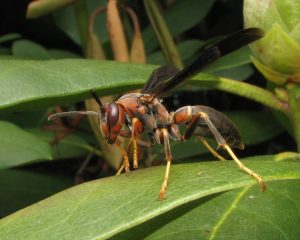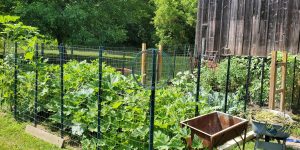Wasps: Heroines for the Lazy Home Gardener
Written by: Victoria Taylor Sluder, Western District Interpretive Services Supervisor
D.I.Y. In my grandmother’s time self-sufficiency was more of a requirement than an option. My generation hasn’t needed to know how to make bread when every grocery store always has racks of bagged loaves waiting for purchase whenever one wants a slice. Why bother with yeast and flour?
Sure, hobby baking is fun and maybe bread machines were a fad for a short while a few years ago. But really, as we have all recently found out, nothing clears the shelves of kitchen staples like a pandemic. Many families must be venturing into unchartered- and unsliced- territory in the face of supply uncertainty. Knowing how to bake your bread guarantees a sandwich when the Wonder runs out.
Having noticed this Spring how quickly all the flats of vegetable plants sold out at the local greenhouses I suspect the same factors are at work in home gardening. I am pleased that so many people are experiencing the joy of growing their own food for the first time and tasting the richness of fresh, homegrown produce. I also know how overwhelming a backyard vegetable garden can feel- especially when there are so many other things to be done in a day- who has time to learn crop rotations and harvesting tables?
There’s a reason these skills became hobbies and real farming remains a full-time job. I’m not above being lazy if there’s an easier way to get my veggies. Among my list of simple shortcuts is this one: welcome wasps.

Those little white butterflies fluttering around my backyard plot are lovely- until they start having babies all over my Brussels sprouts. Baby butterflies- AKA caterpillars- are leaf-eating machines. Just a few turn my kale, cabbage and broccoli leaves into lace. And the gigantic yet incredibly well-camouflaged hornworm caterpillars destroy whole tomato plants- leaves, stems and fruit. But I still feel there is something very wrong about spraying chemical pesticides on anything, let alone what I am going to feed my family. And I just don’t have time to apply and then re-apply organic bug spray or hand-pick all those little leaf-gobblers.
Fortunately, I have a lot of wasps in my yard. Now I know the natural response to wasps is to swat, squish or flee from them. However, hold off- they are the lazy gardener’s friend!
Each wasp you see is making it her business to find and haul away as many caterpillars as she can every day. She’ll either kill and eat them herself, or she’ll take them back to her nest and feed other wasps. Some wasp species, like mud daubers, paralyze the caterpillar then carry it away to lay an egg upon, later becoming food when her baby hatches.
Wasps that live in community nests, like paper wasps or yellow jackets, not only remember and revisit hotspots for food (AKA your garden loaded with caterpillars), but also share info about these locations with their fellow wasps. As a result, some wasps have been reported to prey upon as many as 2,000 different caterpillars. According to studies, the key seems to be the closer the wasp nest to the garden the more beneficial for pest control they can be, particularly for cabbage-damaging caterpillars.

Wasps aren’t particularly picky about the insects they will prey on. Which means that aphids, grasshoppers, leaf beetles and flies are also on their menu. All good news for the gardeners.
True, there will still be some plant-damaging pests the wasps miss so relying on these stinging predators is not 100% effective. But, with zero effort on my part they are making my home garden just a little less DIY. Giving me more time to perfect my no-knead bread recipe.
